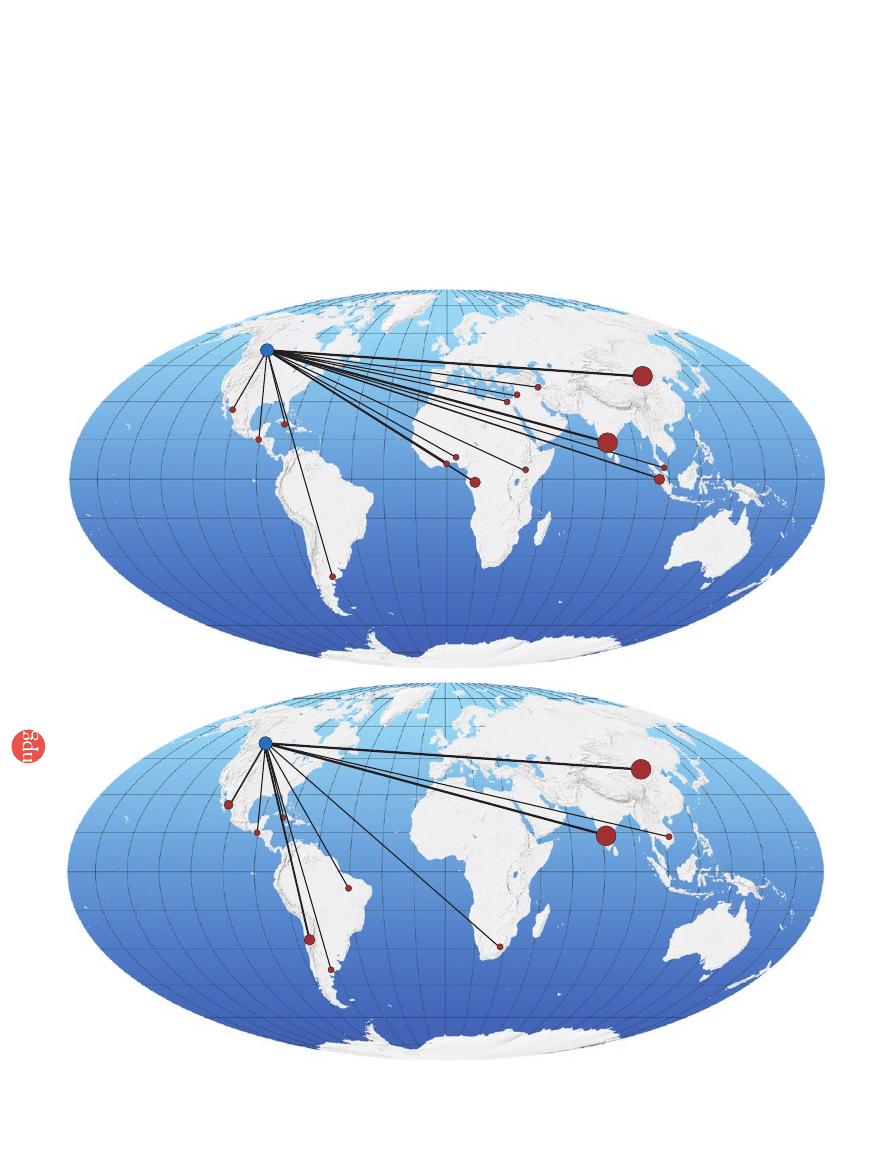
806
volume 27 number 9 september 2009
nature biotechnology
tries. Canada is ranked sixth in the world in
terms of number of publications in interna-
tional peer review journals
11
, and it also ranks
second only to the United States
12
in terms
of the number of health biotech companies.
Even so, its commercialization record is weak.
Only ten firms account for 70% of the market
capitalization of all Canadian biotech firms,
and revenues predominantly come from the
domestic market
13
. Furthermore, even though
the United Kingdom had a similar number of
biotech firms and patents to Canada in 2003, it
had three times more revenue than Canada
13
.
Traditionally, Canadian firms have focused on
forming alliances with firms just south of its
border, seeking market opportunities in the
United States
14,15
. To succeed in health bio-
tech, a more global approach is required, and
this can include partnerships with emerging
economies and developing countries
16
.
To gauge the frequency and characteristics
of Canada’s collaboration with developing
North-South collaborations: Canada as a
model
There are several reasons why North–South
collaboration is valuable for developed coun-
tries’ health biotech firms. Emerging econo-
mies, such as China, India and Brazil, have
large populations, with increasing spending
power and high demand for health biotech
products
2–5
. Collaborating with local partners
is a first step in being able to access these vast
markets. Furthermore, North–South collabora-
tion can help mitigate the high risks and costs
faced in health biotech product development.
For example, the costs of manufacturing, clini-
cal trials and R&D can be lower in developing
countries, and thus North–South collabora-
tion may reduce the cost of the overall drug
development process. Finally, North–South
collaboration can help firms access comple-
mentary assets. The multiplicity of scientific
and technical expertise needed to enable health
biotech product development can be found
worldwide, including within firms and insti-
tutions in developing countries
1,6
.
On the other side, firms in developing
countries enter North–South collaborations
for reasons similar to those of their Northern
partners. They too want to collaborate to
access new markets in the North with popu-
lations that have a high spending power
4,7,8
.
Firms in developing countries also seek col-
laboration with companies from the North
to reduce risk in product development and to
access financing
7
. Moreover, they seek these
types of collaborations to gain access to sci-
entific and technical expertise in developed
countries
3,7,9
. Regulatory expertise can be of
particular importance to firms in developing
countries that are taking their first steps in
innovation
10
.
We chose to focus our study on collabora-
tions between Canada and developing coun-
T
o stay competitive in health biotech,
firms have had to form strategic alliances
that often cross international borders—and
increasingly can involve companies in devel-
oping countries. Capacity in the health bio-
tech field is no longer limited to a handful of
high-income Western countries. Developing
countries themselves have been building up
their expertise
1
and starting their own firms
in the field
2–4
.
Although the potential benefits of collabo-
ration with partners in developing countries
(‘North–South collaboration’) in health bio-
tech are considerable, relatively little is known
about whether these benefits are being realized
and whether ‘Northern’ firms are globalizing by
forming linkages with ‘Southern’ partners. The
aim of this study is to help fill this gap by pre-
senting results from a survey of firms working
in the health biotech sector in Canada about
their collaborations with partners in devel-
oping countries. Even though the focus is on
Canada’s experience in North–South collabo-
ration, the opportunities we identify through
our research can also be harnessed by biotech
companies in other Northern countries. In the
following analysis, we examine the extent of
the collaboration of Canadian health biotech
firms with partners in developing countries,
map where the main linkages lie and explore
the main characteristics and outputs of these
collaborations.
Globetrotting firms: Canada’s health biotechnology
collaborations with developing countries
Monali Ray, Abdallah S Daar, Peter A Singer & Halla Thorsteinsdóttir
A survey of Canadian biotech firms reveals that their biotech collaborations with developing countries are not only
significant but also increasingly reciprocal in terms of the exchange of financial resources and technological know-how.
Monali Ray, Abdallah S. Daar, Peter A. Singer
and Halla Thorsteinsdóttir are at the
McLaughlin-Rotman Centre for Global Health,
University Health Network and University of
Toronto, Toronto, Ontario, Canada; and Halla
Thorsteinsdóttir is also at the Dalla Lana School
of Public Health, University of Toronto, Toronto,
Ontario, Canada.
e-mail: halla.thorsteinsdottir@utoronto.ca
28%
22%
4%
46%
North-North only
Neither North-South nor North-North
Both North-South and North-North
North-South only
Figure 1 Extent of international collaboration by
Canadian health biotech firms.
F E AT U R E
©
2009
Nature
America,
Inc.
All rights reser
ved.

nature biotechnology
volume 27 number 9 september 2009
807
Lexington, Kentucky, US; http://www.
analytictech.com/ucinet/).
Canadian firms have collaborations in all
main regions of the world. Their strongest
developing-country linkages are with China
(22 of the 82 North–South collaboration initia-
tives reported in the survey) and with India (17
collaboration initiatives). Both China and India
have intensified their efforts to build domestic
health biotech capacity in recent years
18,19
. This,
combined with the large market potential avail-
able in these countries, is likely to make them
lucrative partners for Canadian firms. The top
four developed countries that Canadian firms
collaborate with are the United States (116
collaboration initiatives), UK (35 collabora-
tion initiatives), Germany (23 collaboration
initiatives) and Japan (18 collaboration initia-
tives). Thus, our results indicate that Canadian
firms’ collaborations with India and China are
approaching or surpassing their collaborations
with the leading developed countries outside of
the US in the health biotech field.
The survey found Canadian firms also work
with countries in Latin America (21 collabora-
tion initiatives in total). Several countries in
Latin America, such as Brazil and Cuba, are
active in health biotech
7,20
. The continent’s
relative proximity to Canada and its wealth
of natural resources may be additional factors
that make firms based in Latin America attrac-
tive partners for Canadian firms.
In contrast, the level of Canadian firms’ part-
nerships with countries in East Asia and the
international collaborations. A previous study
from our group
17
normalized the data on the
number of firm collaborations with developing
countries with information on the sizes of the
biotech sector in select developed countries.
We found that Canada’s level of North–South
collaboration did not reach the level of collab-
oration by biotech firms in the United States
but was on par with the collaboration levels
of firms from the European Union. The levels
of North–South collaboration we observe for
Canada’s firms are therefore likely to be similar
to the ones observed for most Northern coun-
tries, except the United States.
To learn more about the collaborators, we
collected information regarding the trade
listing (public or private) of the firms we sur-
veyed. Among the 181 respondent firms, 54 are
publicly listed and 127 are private. A substan-
tial number of both public and private firms
(77% and 63%, respectively) are involved in
North–North collaborations. When it comes to
North–South collaborations, Canadian public
and private firms seem to be engaged in these
to similar degrees (24% and 27%, respectively).
Thus, our data does not indicate a difference
in the levels of international collaboration
between public and private firms.
What developing countries are involved?
To examine where Canadian health biotech
firms’ collaborations with developing countries
lie, we visualized the linkages (Fig. 2) using
the software Ucinet 6 (Analytic Technologies,
countries, we sent a brief survey to all the health
biotech firms we could identify in Canada—a
total of 259 firms (see Supplementary Methods
for a detailed description of the study meth-
odology). We asked firms whether they col-
laborated with developing countries and if so,
to list the collaborations and provide further
information regarding these collaboration ini-
tiatives, such as information on the reasons for
the collaboration and the activities involved. We
gave the firms a broad definition of ‘collabora-
tion’, which included any work jointly under-
taken by firms and organizations contributing
to the production of knowledge, products and
services in health biotech. A total of 181 firms
completed the survey (a response rate of 70%),
the results of which are presented below.
How much collaboration is occurring?
Our survey results show that a quarter (26%)
of Canadian health biotech firms are involved
in North–South collaboration (Fig. 1). Most
firms that collaborate with developing coun-
tries are also actively collaborating with devel-
oped countries, which indicates that they seek
alliances widely around the globe. In total,
Canadian firms reported 82 North–South col-
laboration initiatives with developing coun-
tries. Many of these firms have more than
one such collaboration initiative. In com-
parison, nearly half (46%) of Canadian firms
reported collaborations with partners in other
developed countries only. About a quarter
of Canadian firms (28%) report having no
Canada
Cuba
Brazil
South Africa
India
China
Egypt
Mexico
Guatemala
Costa Rica
El Salvador
Panama
Peru
Chile
Uruguay
Argentina
Lesotho
Ghana
Nigeria
Congo
Uganda
Kenya
Philippines
Vietnam
Thailand
Malaysia
Indonesia
Turkey
Iran
Lebanon
Tunisia
Figure 2 The geography of Canada’s North–South collaborations. Both the size of the red node and the width of the connecting line represent the number of
collaborations the developing country has with Canadian firms.
f E aT u r E
©
2009
Nature
America,
Inc.
All rights reser
ved.

808
volume 27 number 9 september 2009
nature biotechnology
at joint distribution and R&D linkages as being
at opposite ends of the spectrum of health bio-
tech collaborations. As we move away from a
focus on distribution to R&D and a stronger
emphasis on new-to-the world knowledge
generation, we seem to lose connections to
Africa and the Middle East but gain connec-
tions to Latin America, especially to Chile and
Mexico.
Manufacturing-related activities are fre-
quently cited in Canadian firms’ collaborations
with Chinese organizations. Nearly half (47%)
of their manufacturing collaboration is with
partners in China. This is perhaps not surpris-
ing as China is the second largest producer of
pharmaceutical ingredients and generic drugs
in terms of value, after the US, and its firms are
moving into the biotech field
22
. Chinese firms
can leverage cost-effective manufacturing
3
in
partnerships with foreign partners.
Canadian firms’ contract research activi-
ties are particularly strong with Indian orga-
nizations versus with other countries. A total
of 43% of Canadian firms’ collaboration in
contract research is with India. This fits well
with previous studies that show Indian con-
tract research organizations to be leveraging
strengths in the areas of synthetic chemistry
and bioinformatics to offer foreign partners
cost-effective investigations in India
2,19
.
We note that ‘using supplies’ has a higher
relative representation in Canadian firms’
collaborations with partners in Latin
American countries than in their collabo-
rations with partners in other developing
countries: 75% of Canadian firms’ collabo-
ration initiatives involving this activity are
with partners in Latin American countries.
The relatively high emphasis on ‘using sup-
plies’ in collaboration with Latin America
may reflect initiatives to harness the conti-
nent’s terrestrial biodiversity.
The study results suggest that Canadian
firms may be leveraging the special strengths
of their developing countries’ partners (tech-
nological, niche areas or other resources) in
the collaborations. This reflects the active
role developing countries have in the col-
laborations and suggests that developing
countries are not simply on the receiving
end of these alliances.
We were interested in exploring whether
Canadian firms have technological strengths
that are particularly attractive to developing
countries’ firms and fuel the collaboration.
We classified the technological foci of the
Canadian firms that reported being involved
in R&D collaborations with developing
countries according to information from
their websites. The firms have a wide range
of technological foci, and discovery tools,
in collaborations that are limited to distribu-
tion activities.
Clinical trials, manufacturing, laboratory
services and contract research are also reported
to be frequent collaboration activities. The col-
laborations also involve provision and use of
supplies (including raw materials, active phar-
maceutical ingredients and so forth) and pro-
vision of training activities, but these occur at
lower frequencies (Fig. 3).
Leveraging competitive advantages. Our sur-
vey results indicate that Canadian health bio-
tech firms have relatively strong distribution
collaborations with China and India, the two
most populous countries in the world (Fig. 4a).
Africa is the world’s second-most-populous
continent after Asia (http://www.worldatlas.
com/aatlas/infopage/content.htm), and so it is
interesting to note that collaborations involv-
ing distribution and marketing with partners
in African countries are on par with such col-
laborations in Latin American countries, even
though Latin America is closer geographically
to Canada. Although there is not a direct rela-
tionship between population size and market
demand, as many people in the more popu-
lous countries cannot afford health biotech
products, the emphasis that Canadian firms
place on distribution and marketing ties with
African countries may reflect the latter conti-
nent’s expanding market potentials.
Canadian firms report having strong R&D
linkages with Chinese and Indian partners (Fig.
4b). Because these two countries have been
building their capacity for innovative research,
this is not surprising
18,19
. Canadian firms also
report significant joint R&D activities with
partners in Latin American countries, such
as Chile, and it is noteworthy that the firms
have closer R&D ties to Latin America than
marketing and distribution ties. We can look
Pacific (8 collaboration initiatives in total), the
Middle East and North Africa (5 collaboration
initiatives in total) and sub-Saharan Africa (9
collaboration initiatives in total) at this time is
relatively low.
Almost all (90%) of Canadian firms’ North–
South collaborations involved at least one type
of formal arrangement among participants.
These ranged from distribution agreements to
joint R&D agreements. Licensing agreements
were cited quite frequently, with over a fifth
of the North–South collaboration initiatives
being based around them. Joint ventures were
rarer, being reported in only 12% of the col-
laboration initiatives. The establishment of
a subsidiary was reported in 13% of the col-
laboration initiatives. Subsidiaries are being set
up not only by Canadian firms in developing
countries, but also by developing countries’
firms in Canada.
Characteristics of collaborations
Canadian health biotech firms’ collaborations
often involve different types of activities; 40%
of firms report involving two or more types
of activities in a single North–South collabo-
ration initiative. The collaborative activities
cover all stages of the health biotech value
chain (Fig. 3).
Collaboration initiatives involving joint dis-
tribution ranked highest in frequency (30% of
the 82 North–South collaboration initiatives).
However, collaborations involving joint R&D
followed closely (28% of the collaboration
initiatives). R&D collaborations are important
for firms because these not only help firms
generate new, proprietary products, but also
enhance a firm’s ability to identify, assimilate
and exploit new knowledge that can provide
the basis for further R&D
21
. These types of
gains and the intensity of knowledge flows in
R&D collaborations are not typically present
0%
5%
10%
15%
20%
25%
30%
P
er
ce
n
ta
g
e
o
f
co
lla
b
o
ra
ti
o
n
initiatives
Distr
ibutio
n
R&
D
Clinical tr
ials
M
an
ufa
ctur
ing
Laborator
y ser
vices
Contract research
Pro
viding supplie
s
Training
Using supplies
Other
Activity
Figure 3 Joint activities in Canada’s North–South collaborations.
f E aT u r E
©
2009
Nature
America,
Inc.
All rights reser
ved.

nature biotechnology
volume 27 number 9 september 2009
809
We note that gaining access to developing
countries’ markets was the reason most fre-
quently cited by Canadian firms for collabo-
rating with developing countries (66% of the
North–South collaboration initiatives). This is
consistent with the observation that the col-
laborations commonly involve marketing and
distribution activities.
The second most frequently cited reason by
Canadian health biotech firms was to provide
in health biotech in general, rather than being
attracted to Canada’s strengths in any par-
ticular subsection of health biotech.
Rationale for collaborations. The survey
results suggest that Canadian firms’ collabora-
tions with developing countries are driven by
a complex mix of reasons, and, in many cases,
respondents reported several reasons for initi-
ating a single collaboration initiative.
biologics and diagnostics firms are all signifi-
cantly involved in R&D collaboration with
developing countries (see Supplementary
Methods online). Our interviews with experts
in health biotech in developing countries,
which are a part of an ongoing case study
on Canada’s collaboration with developing
countries, support the notion that developing
countries wish to work with Canadian firms
because they perceive Canada as being strong
Canada
Cuba
India
China
Egypt
Mexico
El Salvador
Argentina
Ghana
Nigeria
Congo
Uganda
Malaysia
Indonesia
Iran
Lebanon
Canada
Cuba
India
China
Mexico
Costa Rica
Argentina
Brazil
Chile
Vietnam
Lesotho
a
b
Figure 4 The geography of select collaborative activities. (a) Distribution and marketing activities. (b) research & development activities.
f E aT u r E
©
2009
Nature
America,
Inc.
All rights reser
ved.

810
volume 27 number 9 september 2009
nature biotechnology
Collaborations are firm-initiated. We asked
Canadian health biotech firms to indicate
who initiated their collaborations with devel-
oping countries. The results indicate that the
partnerships were almost always initiated by
the partnering firms themselves. Over half of
the collaborations (52% of the North–South
collaboration initiatives) were initiated by the
Canadian firms only, and over a quarter (29%
of the collaborations) were jointly initiated by
Canadian and developing-country partners.
About 12% of the North–South collaboration
initiatives were initiated by partners from devel-
oping countries only. The survey responses did
not indicate expatriates or diaspora communi-
ties as playing a role in helping to set up the
partnerships: only 1 out of 82 collaborations
credited expatriates as helping to initiate the
collaboration. No collaborations at all were
initiated by international organizations.
What is notable is that the collaborations
seem to have arisen without much assistance
from governmental agencies in Canada or in
developing countries—only 7 out of 82 col-
laboration initiatives received government
help in establishing their collaboration.
Previous case-study research has suggested
that a major challenge faced by Canadian
biotech firms in penetrating emerging mar-
kets is a lack of support in establishing ini-
tial linkages with potential partners
23
. With
more government assistance, we might there-
fore expect to observe an even higher level of
Canadian firm collaboration with companies
in developing countries. In this regard, the
establishment of bridging organizations,
such as International Science and Technology
Partnerships Canada (ISTPCanada; Ottawa,
Ontario, Canada), which works at the junc-
tion of domestic and international gov-
ernment desks to promote the country’s
science and technology collaboration with
the emerging economies of China, India and
Brazil (http://www.istpcanada.ca/home/
index.html), is a positive step, although more
needs to be done.
Collaborations fuel the product pipeline.
We asked Canadian firms to specify the
types of output from each of their collabora-
tions. The data indicate that these partner-
ships are productive (Fig. 5) as almost all the
collaborations (90%) report some form of
shared output. More than a quarter (29%)
of the collaborations have joint products in
the pipeline, and 15% of the collaborations
already have joint products in the market.
This reflects a strong product focus. Joint
patenting is, however, rare, with only 4% of
the collaborations reporting joint patents as
an output of collaborations.
In the survey, Canadian firms were given
space to include any additional comments. In 13
of the collaborations, the comments indicated
that Canadian firms are choosing to work with
firms in developing countries to minimize their
development costs and gain access to cheaper
labor and production. The Canadian firms also
cited altruistic reasons (for example, “helping
developing countries” and “to bring wealth we
have here over there”) for their collaborations,
reflecting a moral aspect to partnerships with
firms in developing nations. Still, based on
our survey, we cannot conclude that develop-
ing countries typically receive direct financial
benefits from their health biotech collabora-
tions with Canada. In fact, the opposite seems
to be true as there is significant evidence that
Canada’s North–South health biotech collab-
orations involve bidirectional knowledge and
other flow of resources that leverage strengths
offered by both participating countries.
knowledge to their developing countries’ part-
ners (37% of the collaboration initiatives). The
firms report accessing knowledge from their
developing countries’ partners to be the third
most frequent reason for their collaborations
(24% of the collaboration initiatives). These
findings seem to indicate bidirectional knowl-
edge flows between Canadian firms and their
partners in developing countries.
Canadian firms also cited both providing
financing to developing country partners and
accessing funding from partnerships with
developing country firms (6% and 7% of the
collaboration initiatives respectively) as rea-
sons for their North–South collaborations.
This reflects, once again, that resources are not
necessarily streaming from the North to the
South in Canada’s collaboration with develop-
ing countries. Indeed, there are recent exam-
ples of firms in developing countries providing
financing to firms in Canada (see Box 1).
Box 1 Role reversal? South-to-North resource flows
a key to successful biotech collaboration is reciprocity and equal contribution among
partners. Traditionally, financial resources and science-intensive knowledge have come
from the richer North, so it is a sign of changing times that in some cases these resources
are now originating from the South, flowing into Canadian firms and contributing to their
successes.
The Biosyntech-Piramal Healthcare partnership is an example of collaboration in
which financial resources from a developing country have enabled a Canadian health
biotech firm to continue with its innovative r&D activities. The Canadian firm Biosyntech
(Montreal; http://www.biosyntech.com/en/) is involved in the development of thermogels
for tissue repair and drug delivery. after encountering difficulty in raising financing from
North american venture capitalists, company management approached one of India’s
largest pharmaceutical firms, Piramal Healthcare (Mumbai; http://www.npilpharma.
com/about-us/piramal-group.html), for funding. Piramal Healthcare, in exchange for
distribution and research collaboration agreements, made a CDN$6 million (uS $5.4
million) equity investment in the Canadian firm in 2006. as a result of this investment
by the Indian firm, Biosyntech was able to stay afloat and raise subsequent funding from
North american investors. The Canadian firm credits its Indian partner for keeping it alive,
and Biosyntech’s has now been able to push its proprietary therapy for localized cartilage
lesion repair into clinical testing.
an example of another type of resource flow from South to North is the joint venture
between the Canadian firm YM BioSciences (Mississauga, Ontario, Canada; http://www.
ymbiosciences.com/) and the Cuban research institution Centre for Molecular Immunology
(Havana). In this case, it is Southern technology and know-how that is being transferred
to the Northern partner, rather than funding. The Canadian firm does not conduct its
own basic research. Its first in-licensed technology was a cancer therapy technology from
the Centre for Molecular Immunology in 1995. Cuban scientists did the original basic
research and are manufacturing the anticancer, epidermal growth factor receptor–targeting
humanized monoclonal antibody nimotuzumab. Today, YM BioSciences is conducting
phase 1 to 3 trials of nimotuzumab in Europe, North america, asia and Latin america,
itself and through several companies that have licensed development rights from YM
BioSciences. The trials are being conducted for various cancer types, including non-
small-cell lung, glioma, esophageal, colorectal, pancreatic, prostate, cervical and breast.
Nimotuzumab is approved in several countries for the treatment of head and neck cancers
and glioma. Licensing technology from its Southern partner has enabled YM BioSciences
to develop an advanced portfolio in oncology; the firm has been named among Canada’s
top ten life sciences companies two years in a row.
f E aT u r E
©
2009
Nature
America,
Inc.
All rights reser
ved.

nature biotechnology
volume 27 number 9 september 2009
811
tion potentials. Health biotech is increasingly
global in scope, and without global partner-
ships the firms will not be able to remain
competitive. We do not, however, have survey
data on further benefits of the collaboration.
As the collaborations seem to be young, they
are unlikely to have already led to significant
increases in revenues.
To see whether there are any differences
between firms that are involved in North–
South collaborations versus those that are not,
we selected the public firms in our data set and
compared financial information of those pub-
licly listed Canadian firms that reported hav-
ing North–South collaboration to those that
did not. Both the average total assets and R&D
expenditures were similar between the firms
that have been involved in North–South col-
laboration and those that have not (Table 1).
We do note, however, that average total rev-
enues of firms that have North–South collabo-
rations are nearly four times higher than firms
that do not have such partnerships. Even after
removing the top revenue earner from the
group that has North–South collaborations,
the adjusted average total revenue is double
that of the other group. Thus, our data sug-
gests that Canadian public health biotech
Ongoing case study research indicates that
most Canadian health biotech firms are taking
their first steps in North–South partnerships.
Their limited joint patenting further strength-
ens the notion that these types of collabora-
tions are young, and it is likely that we will see
more joint patenting as the partners become
more familiar with one another and collabo-
rations progress. There are great expectations
that the collaborations will open up new
markets and strengthen the firms’ innova-
A few firms indicated that the collaboration
with developing countries has led to ‘other’
forms of joint outcomes (9%). They specified
these to include joint R&D projects, entering
into distribution agreements and beginning
clinical phase studies, among other things.
Thus, North–South collaboration can be
important to firms achieving milestones of the
drug development process, as well as distribu-
tion and marketing agreements. We provide
examples of these in Boxes 1–4.
0%
5%
10%
15%
20%
25%
30%
P
er
ce
n
ta
g
e
o
f
co
lla
b
o
ra
ti
o
n
initiatives
Joint product
in pipeline
Output
Joint product
in market
Joint
publication
Joint
patent
Other
None
Figure 5 Joint output in Canada’s North–South collaborations.
China and Canada affirmed their commitment to work together
by signing a bilateral science and technology agreement in
January 2007. Collaborating across the Pacific Ocean is a natural
development for the two asia-Pacific Economic Cooperation (aPEC)
states and is undoubtedly facilitated by the fact that Canada has
had a continuous immigration stream from China and, as a result,
a sizeable Mandarin- and Cantonese-speaking population. In health
biotech research, their collaboration is fueled by their populations’
shared health problems. Both have aging populations and thus a
high burden of non-communicable disease (http://www.who.int/
whosis/whostat/EN_WHS08_full.pdf). In addition, communicable
diseases spread easily between the two countries. This was
illustrated by the severe acute respiratory syndrome (SarS)
epidemic in 2003, which spread to Canada a matter of weeks after
its outbreak in China; indeed, Canada had the third-highest number
of reported cases in the world
24
. It is, therefore, not altogether
surprising that our survey on Canadian firms’ health biotech firms
showed China as Canada’s foremost developing-country partner in
the field. The Canadian firms are likely to be attracted to the large
market in China, which is home to over a billion people, as well as
to China’s r&D and manufacturing strengths. Canada is likely to be
an attractive partner to China because it has a strong track record
in biotech and has developed promising technologies in the field.
In 2008, ProMetic Life Sciences (Montreal), a Canadian
biopharmaceutical company, entered into collaboration with the
Wuhan Institute of Biological Products (WIBP; Wuhan, China), a
subsidiary of China National Biotec Group (CNBG), for ProMetic’s
affinity-separation technology for extracting and purifying proteins
from human plasma at high yields. according to Lifang Wang,
president and CEO of CNBG, “The integration of ProMetic’s
technologies into WIBP’s existing manufacturing infrastructure
will significantly increase WIBP’s manufacturing capacity and
enable WIBP to better meet the ever-growing demand in China.”
Initial products targeted include thrombin, fibrinogen, intravenous
immunoglobin, anti-hepatitis B immunoglobin, anti-rabies
immunoglobin and anti-tetanus immunoglobin. The strategic
alliance is therefore aimed at strengthening WIBP’s manufacturing
capacity through innovative technology and broadening ProMetic’s
reach into a rapidly expanding market (http://www.prometic.com/
en/prometic/index.php).
another Canadian firm actively working with Chinese partners
to penetrate the Chinese drug market is Welichem Biotech
(Vancouver, British Columbia, Canada; http://www.welichem.
com/index.php). Welichem’s discovery platform enables the
identification of novel anti-inflammatory or antiproliferative
compounds from bacteria symbiotic with insects and nematodes.
The company’s lead drug WBI-1001, a non-steroidal anti-
inflammatory cytokine modulating compound is being developed as
a cream for the treatment of psoriasis, eczema and inflammatory
bowel disease. In 2005, Welichem entered into a strategic
partnership with Weihe Pharmaceutical (Yuxi, China) and Celestial
Pharmaceuticals (Shenzhen, China) for the cost-effective,
development and marketing of novel drugs discovered through the
Canadian company’s platform. The Chinese partners planned a
uS$ 50 million investment over three years into Welichem and the
firms are establishing a r&D laboratory in China. Joint r&D at the
preclinical level and transfer of senior management has thus far
been conducted to deepen the synergies between the partners.
Box 2 Collaborating with the Dragon of the East
f E aT u r E
©
2009
Nature
America,
Inc.
All rights reser
ved.

812
volume 27 number 9 september 2009
nature biotechnology
successes of initiatives promoting Canadian
firms’ collaboration with developing countries
in health biotech.
Although we have focused our research on
Canadian firms’ collaborations, the findings
from the study are relevant to other devel-
oped countries because it gives an indication
of the potential of North–South collaboration
in general to strengthen innovation in health
biotech. The findings may be useful to firms
interested in global expansion, to research
groups considering entrepreneurial alliances
and to government policymakers who are in a
position to influence innovation, development
or foreign affairs policies in both developed
and developing countries.
There are several conclusions from our study
of entrepreneurial collaborations between
Canadian health biotech firms and develop-
ing countries. First, these types of partnerships
are widespread. Canada has frequent ties to
developing countries, with over a quarter of its
health biotech firms collaborating with devel-
oping countries. Firms that engage in North–
South collaboration seem to be involved in a
number of collaboration initiatives with their
partners. The survey results show Canadian
firms report having a similar number of col-
laboration with companies in the develop-
ing economies of China and India as they do
with companies in developed countries, such
as Germany, Japan and France. Developing
countries that have invested in their domestic
health biotech sectors seem best poised to par-
ticipate in global health biotech networks, and
their respective strengths attract collaboration
with Northern partners.
Second, collaborations have a relatively
strong focus on R&D activities. Responses
from Canadian health biotech firms show that
R&D activities are nearly as common as distri-
bution and other end-stage commercialization
activities in their North–South collaboration
initiatives, reflecting a significant degree of
knowledge-intensive collaboration between
Canadian firms and their developing coun-
try partners. This focus on joint R&D has the
potential to increase learning and innovation
in both the South and the North.
Third, our study results suggest that
Canadian firms’ collaborations with devel-
oping countries are based on leveraging both
partners’ competitive strengths. Developing
countries may be relying on existing strengths
in specific areas—technological, service-based
or resource-based—to work with Canadian
firms. Bidirectional transfer of knowledge is
an important reason for forming these North–
South partnerships. We also note bidirectional
flow of capital between Canadian and develop-
ing countries’ partners. The collaborations are
Conclusions
Our survey casts light on the current extent
and characteristics of the collaboration of
Canadian health biotech firms with partners
in developing countries. The results also pro-
vide a baseline to which future studies on this
topic can compare, thereby affording the pos-
sibility to evaluate changes over time and the
firms that have North–South collaborations
generate higher revenues than those that do
not. Still, as our data are limited, we cannot
attribute the companies’ increased revenues
to their North–South collaboration, as an
alternative explanation may be that the firms
that have the highest revenues are the most
outward looking.
Box 3 The global face of clinical trials
Taking a healthcare product from concept to proof-of-concept and finally regulatory
approval is a long, arduous process. firms, therefore, commonly choose to carry out
testing of product safety and efficacy in partnerships. Our survey of health biotech firms
in Canada shows that these partnerships can cross the world and be between Canada
and developing countries’ firms. It is important for firms to work with experienced local
partners to assess effectiveness and safety of a trial product in different populations
thereby gaining information for optimal design of the product and to navigate the local
regulatory system.
In 2006, the Juravinski Cancer Centre’s (Hamilton, Ontario, Canada) clinical trial
group was chosen as a trial site by Piramal Healthcare (Mumbai, India) to pursue its
first-in-human trials of its novel anticancer molecule. Piramal Healthcare is interested
in entering its proprietary products in global markets, including in North america, and
as such decided to conduct trials at North american sites. It also is taking its first
steps in innovative discovery and wanted to test its novel product in a country with a
regulatory system that has a strong track record in testing innovative drug candidates.
The trial was conducted at the Juravinski Cancer Centre under International Committee
for Harmonization/Good Clinical Practice and Health Canada regulatory guidelines. Hal
Hirte, Chief of Oncology at the Centre, notes that due to the “reciprocities” between the
Canadian regulatory system and that of the uS fDa, it is easier for clinical data collected
in Canada to be accepted in the uS in comparison to data collected elsewhere in the
world. It is also cheaper for Piramal Healthcare to carry out initial trials in Canada than in
the united States because Canada’s universal healthcare system covers part of healthcare
costs. The Juravinski Cancer Centre is now in discussion with Piramal Healthcare to
continue with phase 2 trials of the anticancer drug.
Elsewhere, SpectraDigital (Guelph, Ontario, Canada; http://www.spectradigital.net/
index.php), a small Canadian firm interested in tapping into the Brazilian market with
its diagnostic technology, has partnered with fK Biotec (Porto alegre, Brazil; http://
www.fkbiotec.com.br), a Brazilian immunodiagnostics firm. SpectraDigital’s diagnostic
technology platform uses light-scattering measurements and image processing techniques
to allow inexpensive diagnosis of HIV, Plasmodium, multi-drug-resistant tuberculosis
bacilli and various types of tumors—all diseases of local relevance in Brazil. as a small
firm, SpectraDigital’s business model depends on partnerships to implement its platform
in global markets. It is relying on the infrastructure, contacts, distribution channels,
financial investment and regulatory know-how of fK Biotec to demonstrate proof of
concept and take the final product to market. Satish Deshpande of SpectraDigital notes
that his firm is able to enter the Brazilian market owing to its linkages with an experienced
local partner while larger firms have stayed out of this market because of difficulties
faced in understanding and negotiating the regulatory channels there. from fK Biotec’s
perspective, however, CEO fernando Kreutz says, “It’s not only a simple clinical trial. It
is more than that because we are actually involved in further development of the product,
finding new applications, improving the range of product applicability.”
Table 1 Canadian health biotech public firms: 2007 financial data
Financial benchmark
Firms with North–South
collaborations (US$ millions)
Firms without North–South
collaborations (US$ millions)
average total assets
33.6
40.4
average r&D expenditure
11.9
15.5
average total revenues
16.3
4.4
f E aT u r E
©
2009
Nature
America,
Inc.
All rights reser
ved.

nature biotechnology
volume 27 number 9 september 2009
813
ized world. Furthermore, our data indicate that
thus far, the Canadian government has played
only a limited role in promoting and helping to
establish collaborations of health biotech firms
with developing countries. Despite this limited
role, around a quarter of Canadian firms col-
laborate with developing countries. Many firms
are, however, likely to be timid in approaching
far away countries for partnership building.
The Canadian and other developed country
governments are in a position to facilitate the
initiation of partnerships and can raise aware-
ness of the potential benefits to North–South
collaborations.
Governments in developing countries
likewise need to integrate their innovation
agenda and their foreign-affairs policies. They
also need to diversify their linkages and focus
on countries that are strong in health biotech.
Our previous research has shown that there
still is a tendency for developing countries
to collaborate in health biotech with coun-
tries that they have had historical ties to in
the form of former colonial relations
18
. In
technology-intensive fields, such as health
biotech, there is a need for developing coun-
tries to diversify and see that the world can
be their playing field.
the various phases of clinical trials on inno-
vative products and a system geared to regu-
late such innovative efforts. Furthermore, as
Canada is geographically close to the United
States and has some cultural similarities, with
strong parallels in regulatory oversight, collab-
oration with Canadian firms provides develop-
ing countries’ firms with a stepping stone to the
lucrative US market.
Governments in developed countries should
realize that the global innovation landscape is
changing and can increasingly involve con-
tributions from developing countries. So far,
innovation policies of developed countries have
primarily focused on internal ‘national’ visions,
or have prioritized international partnerships
with other developed countries to drive innova-
tive behavior. They have paid limited attention
to the potential of collaborating with develop-
ing countries to stimulate domestic innovative
capabilities. What our results suggest is that this
needs to change. To maintain global competi-
tiveness in health biotech, developed countries
must broaden the scope of their innovation
agendas to include partnerships with develop-
ing countries. Innovation policies and foreign
affairs policies need to be integrated to pro-
mote collaboration and innovation in a global-
not unidirectional in terms of contributions:
developing countries’ firms and organizations
are active participants in their joint initiatives
with Canadian firms.
Fourth, the majority of Canada’s entrepre-
neurial health biotech partnerships have been
initiated by the participating firms without
external intervention either from Canada or
the partnering country. International orga-
nizations and diaspora communities have
not played a significant role in encouraging
North–South collaboration. Canadian firms
have received some help from government
agencies, such as the ministries of trade or for-
eign affairs, in both the North and the South,
but this has been limited in nature. There is
clearly a great deal more bridging that could be
done to ensure that North–South collaboration
is able to thrive and meet its potential.
Finally, the collaborations are strongly
focused on products. Our data show that
North–South partnerships are productive and
almost all of them have led to some shared
output. The most common output is a joint
product in the pipeline, although some col-
laborations have a joint product already on
the market. Considering the focus on prod-
uct development, collaborations could, in the
future, be a strong force in innovation. There is,
however, reason to believe that the partnerships
are nascent, and, considering the high uncer-
tainty of drug development, it is premature to
evaluate their benefits in terms of marketed
new-to-the world innovation, revenues and
job creations.
Overall, our survey indicates that Canadian
firms have a strong interest in building part-
nerships in the health biotech sector with firms
in developing countries. On the basis of this
research, several recommendations can be
made to strengthen this process with inputs
from various stakeholders. Canadian firms
that are looking into new market opportunities
should increasingly consider firms in develop-
ing countries. By partnering with these firms,
they can gain access to the latter’s local market-
ing intelligence and distribution networks. Our
research demonstrates that the partnerships do
not have to focus solely on marketing activities
but can also strengthen innovation pipelines.
Developing countries’ firms are collaborating
with Canadian biotech firms to gain access to
their technological expertise and experience in
product development. Canada has strengths in
biotech, reflected in its high publication rate
in international peer-reviewed journals and
large number of firms active in the field
12,13
.
For developing countries’ firms taking their
first steps in new-to-the world innovation, it
is likely to be beneficial to form partnerships
with firms that already have experience with
Box 4 International commercialization of needle-free insulin
In 2001, frost & Sullivan awarded its Product Differentiation Innovation award to the
Canadian firm Generex Biotech (Toronto; http://www.generex.com/) for a proprietary
formula (containing cyclodextrin, a mucobioadhesive polymer carboxmethycellulose, the
surfactant sodium lauryl sulfate, viscosity-control polymer hydroxypropyl methycellulose
and urea peroxide) that facilitates the delivery of large-molecule drugs to the buccal
mucosa. Generex has developed Oral-Lyn, a formulation of insulin mixed with the
delivery formulation that patients can self administer via a device (rapidMist) capable of
aerosolizing the drug by means of a chemical propellant. Oral-Lyn thus offers needle-free
delivery of the hormone to patients with type I and type II diabetes. Early on, Generex
realized that in addition to conducting testing and clinical trials in North america,
turning to international commercial partners—particularly in developing countries, where
the diabetes epidemic is expected to swell, according to the World Health Organization
(Geneva)
25
—would be a critical component of its strategy to increase support,
endorsement and ultimately acceptance of its product worldwide and at home.
Generex took its first step toward international registration and commercialization
of Oral-Lyn in Ecuador. after gaining clearance from the Ecuadorian Ministry of Public
Health, the company in 1998 began clinical testing of the product’s safety and efficacy
in collaboration with local investigators at the Instituto de Endocrinologia Metabolismo
y reproducción (IEMYr; Quito, Ecuador). Generex also entered into an alliance with
PharmaBrand, a local Ecuadorian pharmaceutical firm, and together the partners
successfully gained regulatory approval to commercialize Oral-Lyn in Ecuador in 2005.
The alliance gave a boost to PharmaBrand and strengthened its position in Latin america.
Generex also benefitted from its connections in Ecuador. Presentation of Oral-Lyn’s
clinical trial data by IEMYr researchers at many international conferences significantly
increased awareness of the product by a global audience. Oral-Lyn’s successful registration
in Ecuador renewed investor confidence in Generex. It also served as a springboard to
Generex forming further Oral-Lyn licensing and distribution agreements with partners
across the globe, including SciGen (Hefei, China), adcock Ingram (Johannesburg, South
africa), Dongsung Pharmaceutical (Seoul, South Korea), Shreya (Mumbai, India) and
Banaja (Jeddah, Saudi arabia).
f E aT u r E
©
2009
Nature
America,
Inc.
All rights reser
ved.

814
volume 27 number 9 september 2009
nature biotechnology
tries. Int. J. Biotechnol.
8, 23–42 (2006).
12. van Beuzekom, B. & arundel, a. OECD biotechnology
statistics. (OECD, Paris, 2006).
13. Munn-Venn, T. & Mitchell, P. Biotechnology in Canada:
a technology platform for growth (Conference Board of
Canada, 2005).
14. Traore, N. Canadian biotech firms: extent of networking
activities and commercialization success. Innov. Anal.
Bull.
3, 13–14 (2001).
15. Biotecanada. Canadian and uS biotechnology com-
panies forging new partnerships at the 2007 Bio
International Convention (May 2007). <http://www.
lifesciencesbc.ca/News/>
16. Dufour, P. Taking the (right?) fork in the road: Canada’s
two-track approach to domestic and international sci-
ence and technology. Sci. Public Policy
29, 419–430
(2002).
17. Melon, C.C. et al. a survey of South–North health
biotech collaboration.
Nat. Biotechnol. 27, 229–232
(2009).
18. Zhenzhen, L. et al. Health biotechnology in China—
reawakening of a giant. Nat. Biotechnol.
22 (suppl.),
DC13–DC18 (2004).
19. Kumar, N.K. et al. Indian biotechnology—rapidly evolv-
ing and industry led. Nat. Biotechnol.
22 (suppl.),
DC31–DC36 (2004).
20. ferrer, M., Thorsteinsdóttir, H., Quach, u., Singer, P.a.
& Daar, a.S. The scientific muscle of Brazil’s health
biotechnology. Nat. Biotechnol.
22 (suppl.), DC8–DC12
(2004).
21. Coe, D.T., Helpman, E. & Hoffmaister, a.W. North-south
r&D spillovers. Econ. J.
107, 134–149 (1997).
22. Yusuf, S., Nabeshima, K. & Perkins, D.H. China and
India reshape global industrial geography. in Dancing
with Giants: China, India and the Global Economy.
Pages 35–66. Editors: Winters, L.a. & Yusef, S. The
World Bank: Washington, D.C. (2007).
23. Taylor, a.D. et al. North–South partnerships—a study
of Canadian firms. Nat. Biotechnol.
25, 978–979
(2007).
24. Zhong, N.S. & Wong, G.W.K. Epidemiology of severe
acute respiratory syndrome (SarS): adults and chil-
dren. Paediatr. Respir. Rev.
5, 270–272 (2004).
25. Wild, S., roglic, G., Green, a., Sicree, r. & King, H.
Estimates for the year 2000 and projections for 2030.
Diabetes Care
27, 1047–1053 (2004).
McLaughlin Centre for Molecular Medicine. P.A.S. is
supported by a Canadian Institutes of Health Research
Distinguished Investigator award. H.T. is supported by
a New Investigator Award from the Canadian Institutes
of Health Research.
COMPETING INTERESTS STATEMENT
The authors declare competing financial
interests: details accompany the full-text HTML
version of the paper at http://www.nature.com/
naturebiotechnology/.
1. Thorsteinsdóttir, H., Quach, u., Daar, a.S. & Singer,
P.a. Conclusions: promoting biotechnology innovation
in developing countries. Nat. Biotechnol.
22 (suppl.),
DC48–DC52 (2004).
2. frew, S.E. et al. India’s health biotech sector at a cross-
roads. Nat. Biotechnol.
25, 403–417 (2007).
3. frew, S.E. et al. Chinese health biotech and the three-
billion patient market. Nat. Biotechnol.
26, 37–53
(2008).
4. rezaie, r. et al. Brazilian health biotech—fostering
crosstalk between public and private sectors. Nat.
Biotechnol.
26, 627–644 (2008).
5. rao, S. The rise of the BrICS: what does it mean for
Canada? (Conference Board of Canada, 2008).
6. Wagner, C.S. The new invisible college: science for
development (Brookings Institution, Washington, DC,
2008).
7. Thorsteinsdóttir, H., Saenz, T.W., Quach, u., Daar, a.S.
& Singer, P.a. Cuba – innovation through synergy. Nat.
Biotechnol.
22 (suppl.), DC19–DC24 (2004).
8. Chataway, J., Tait, J. & Wield, D. frameworks for phar-
maceutical innovation in developing countries – the
case of Indian pharma. Technol. Anal. Strateg.
19,
697–708 (2007).
9. Mytelka, L.K. Pathways and policies to (bio)pharma-
ceutical innovation systems in developing countries.
Ind. Innov.
13, 415–435 (2006).
10. Bower, J.D. & Sulej, J.C. The Indian challenge: the
evolution of a successful new global strategy in the
pharmaceutical industry. Technol. Anal. Strateg.
19,
611–624 (2007).
11. Thorsteinsdottir, H., Daar, a.S. & Singer, P.a. Health
biotechnology publishing takes-off in developing coun-
Biotech investors must also embrace the
fact that innovation in health biotech increas-
ingly involves global players and components.
To recoup developmental costs, firms need
to market their products widely around the
world. For many small firms, investors are
the main advisors for business strategies, and
an increasing appreciation of the benefits
of North–South innovation and its role in
business models is likely to be important for
the future success of biotech enterprises. To
maintain global competitiveness in health bio-
tech, developed countries must broaden the
scope of their innovation agendas to include
partnerships with developing countries. To
do so, different stakeholders must align their
strategies so they can work together toward
the common goal of promoting cost-effective
health innovation of mutual benefit to the
North and the South.
ACKNOWLEDGMENTS
The authors thank all the firms that responded to the
survey and generously shared their expertise and time.
We also thank J. Clark for comments on the manuscript
and J. Chadder and M. Li for help with data collection.
This project was funded by the Canadian Institutes of
Health Research and supported by the McLaughlin-
Rotman Centre for Global Health. The McLaughlin-
Rotman Centre for Global Health, Program on Ethics
and Commercialization is primarily supported by
Genome Canada through the Ontario Genomics
Institute, the Ontario Research Fund, and the Bill and
Melinda Gates Foundation. Other matching partners
are listed at http://www.mrcglobal.org/. M.R. is
supported by a Canadian Institutes of Health Research
Training Award. A.S.D. and P.A.S. are supported by the
f E aT u r E
©
2009
Nature
America,
Inc.
All rights reser
ved.
Document Outline
- Globetrotting firms: Canada’s health biotechnology collaborations with developing countries
- North-South collaborations: Canada as a model
- How much collaboration is occurring?
- What developing countries are involved?
- Characteristics of collaborations
- Conclusions
- ACKNOWLEDGMENTS
- COMPETING INTERESTS STATEMENT
- REFERENCES
- Figure 1 Extent of international collaboration by Canadian health biotech firms.
- Figure 2 The geography of Canada’s North-South collaborations
- Figure 3 Joint activities in Canada’s North-South collaborations.
- Figure 4 The geography of select collaborative activities
- Figure 5 Joint output in Canada’s North-South collaborations.
- Box 1 Role reversal? South-to-North resource flows
- Box 2 Collaborating with the Dragon of the East
- Box 3 The global face of clinical trials
- Box 4 International commercialization of needle-free insulin
- Table 1 Canadian health biotech public firms: 2007 financial data
Wyszukiwarka
Podobne podstrony:
806
806
BS EN 806 pt3
BS EN 806 pt2
(11) Transfer i integracjaid 806 ppt
BS EN 806 pt1
806
806
806
806 807
BS EN 806 pt5
806
Instrukcja LYD 806
806 807
806 Kod ramki szablon
Peugeot 806 clusterplug
więcej podobnych podstron